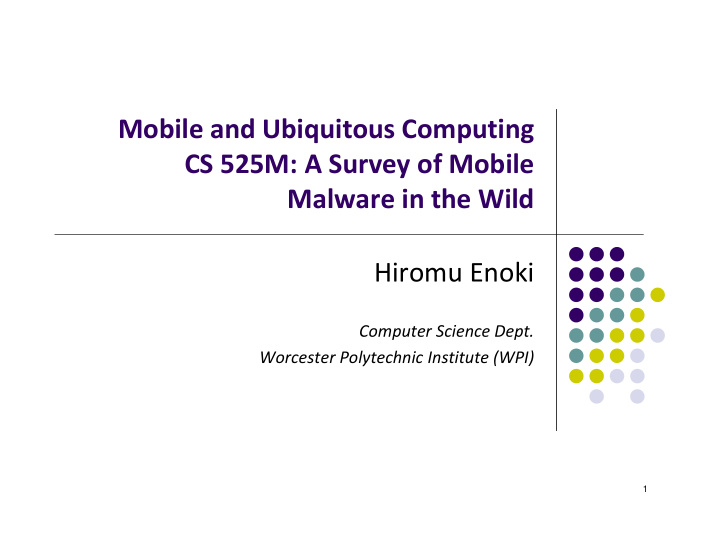



Mobile and Ubiquitous Computing CS 525M: A Survey of Mobile Malware in the Wild Hiromu Enoki Computer Science Dept. Worcester Polytechnic Institute (WPI) 1
Introduction Mobile Malware is fairly recent July 2004 – Cabir virus came out on Symbian August 2010 – Fake Player on Android July 2012 – Find and Call on iOS Evolving rapidly Amusement Credential Theft SMS spam Ransomware 2
Introduction Sensitive personal information on mobile device E ‐ mail, contacts, passwords… Root exploits and Jailbraking Exploits used by both users and adversaries Any easy way of defending against malwares? Permissions? OS features? App reviews? 3
Related Work Extensive research done on PC malwares Feasibility and profitability of mobile malware has been researched since 2004 Spam, Identity theft, DDoS, wiretapping were predicted Malware on other mobile platforms 4
Background – Application Markets Apple App Store All applications are reviewed by human iOS devices can only obtain apps through here, unless jailbreaked Google Play (Android Market) Some applications may be reviewed Does not restrict installing apps from other markets Symbian Ovi Security automatically reviewed by program Risky applications are reviewed by human 5 Can install apps from other markets
Methodology Analyzed information about 46 malwares that spread between Jan. 2009 – June 2011 4 – iOS 24 – Symbian 18 – Android Information from anti ‐ virus companies and news sources Omitted spyware and grayware 6
Methodology Analyzed permissions of 11 Android malwares Categorized and counted how many permissions they require Attempted to determine malware from permission requests Researched on 6 Android devices of root exploits Compared firmware release dates with root hack information on xda ‐ developers 7
Results 8
Novelty and Amusement Minor damage Changing wallpapers, sending annoying SMS A preliminary type of malware Expected to decrease in number 9
Selling User Information Personal information obtained via API calls Location, contacts, history, IMEI Information can be sold for advertisement $1.90 to $9.50 per user per month IMEI information can be used to spoof blacklisted phones 10
Stealing User Credentials Malwares can intercept SMS to circumvent two ‐ factor authentication Done in conjunction with phishing on desktops Keylogging and scanning documents for passwords Application sandboxing prevents most of these 11
Premium ‐ Rate Calls and SMS Premium ‐ rate calls and SMS directly benefits adversaries Few dollars per minute or SMS 24 of the 46 malwares send these Mostly on Android and Symbian iOS avoids this by always showing confirmation for outgoing SMS messages 12
SMS Spam Distributing spam origin makes blocking harder Less noticeable when having unlimited SMS Phone numbers are more “reliable” than e ‐ mail Can be prevented by enforcing SMS to be sent from a designated confirmation window 13
Search Engine Optimization (SEO) Clicks on a certain link on a search query to increase visibility Phishing websites use this technique, along with desktop malware Can be prevented with affixing an application ‐ unique tag on the HTTP request Privacy concerns? 14
Ransomware Kenzero – Japanese virus included in pornographic games distributed on the P2P network Asked for Name, Address, Company Name for “registration” of software Asked 5800 Yen (~$60) to delete information from website (Paper information is wrong) About 661 out of 5510 infections actually paid (12%) Not many Ransom malwares on mobile yet…. 15
Possible Future Malware Types Advertising Click Fraud Invasive Advertising (AirPush) In ‐ Application Billing Fraud Government spying E ‐ mail Spam DDoS NFC and Credit Cards 16
Android Malware Growth Trend Micro PDF http://www.trendmicro.com/cloud ‐ content/us/pdfs/security ‐ intelligence/reports/rpt ‐ evolved ‐ threats ‐ in ‐ a ‐ post ‐ pc ‐ world.pdf 17
Android Malware Permissions 8 out of 11 malwares request to send SMS (73%) Only 4% of non ‐ malicious apps ask for this READ_PHONE_STATE is used by 8/11 malwares Only 33% for non ‐ malicious apps Malware asks on average 6.18 dangerous permissions 3.46 for Non ‐ malicious apps 18
Root Exploits Rooting allows higher level of customization Installing from unofficial markets System Backups Tethering Uninstalling apps However, malwares can take advantage of root commands to obtain permissions 19
Root Exploits Root exploits available for 74% of device lifetime Malware authors do not need to investigate them, but the community does 20
Conclusion Mobile malware rapidly grew in number Profitability is the current trend for malwares Defense against mobile malware requires more research Human review are effective methods to prevent malware Rooting benefits both users and malware producers 21
Thank You! Questions? 22
References A survey of mobile malware in the wild Adrienne Porter Felt, Matthew Finifter, Erika Chin, Steve Hanna, and David Wagner. in Proc. SPSM 2011. World’s First Android Virus, Nikkei ITPro, http://itpro.nikkeibp.co.jp/article/NEWS/20100816/3 51137/ Bluetooth ‐ Worm:SymbOS/Cabir, F ‐ Secure Threat Description, http://www.f ‐ secure.com/v ‐ descs/cabir.shtml 23
References Find and Call: Leak and Spam, Securelist, http://www.securelist.com/en/blog/208193641/ Kenzero: 40 times more successful than traditional spoofs, http://internet.watch.impress.co.jp/docs/news/2010 0401_358380.html AirPush : la publicité dans les notifications qui ressemble à du malware, http://www.frandroid.com/applications/92449_airp ush ‐ la ‐ publicite ‐ dans ‐ les ‐ notifications ‐ qui ‐ ressemble ‐ 24 a ‐ du ‐ malware
Recommend
More recommend